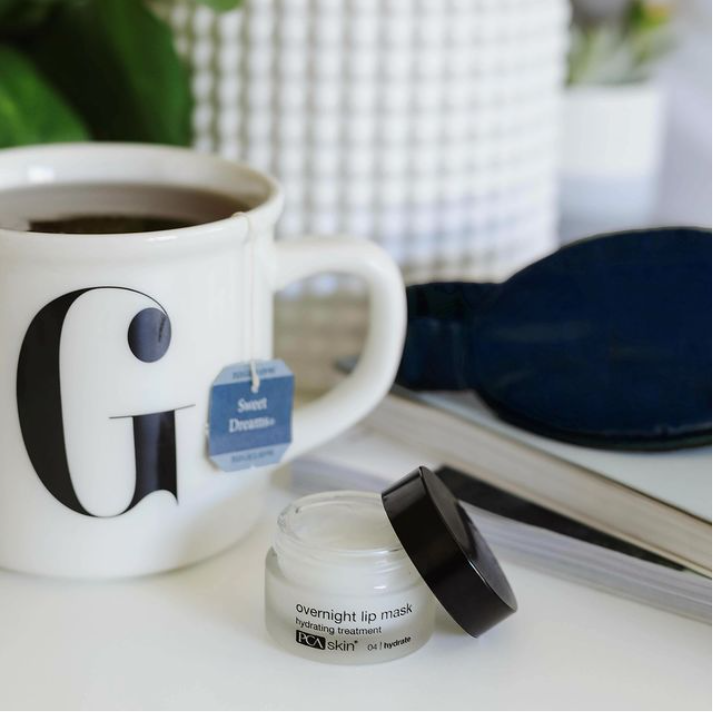
Wake up feeling hydrated with PCA Skin® Overnight Lip Mask!
It’s inevitable that everyone has experienced dry, chapped lips in their life time and will continue too, the simple fact is the skin on our lips is completely different to the skin on the rest of our face.
Let’s look at some of the facts.
-
Lips are a lot thinner.
-
The lips have three to five cellular layers while the face has approximately 16 layers.
-
Lips are a different colour.
-
There are fewer melanocytes, so blood appears more visible making the red colour of the lips.
-
Lips cannot produce lipids naturally.
-
Lips dry out faster.
-
No hair follicles or sweat glands are found in the lips. ○ Less effective protection from sweat and body oils that keep the skin smooth, inhibit bacteria, and regulate temperature.

Because of all these contributing factors the naturally drier and thinner skin can become chapped and uncomfortable more easily due to the overall reduction in protection.
What ingredients will help dry, chapped lips?
Because of the lips structure they require a blend of emollient and occlusive ingredients to ensure instant and longer lasting hydration.

Squalene - A naturally occurring emollient oil that is found naturally in olives and wheat germ. Provides a light, cosmetically elegant feel and will protect the skin’s lipids and reduces TEWL resulting from barrier dysfunction.
Shea Butter - provides an emollient layer over the lips to add hydration but is also an occlusive, to lock in moisture and leaves a non-greasy texture longer term.
Tocopherol - or Vitamin E as its more commonly known is an emollient antioxidant that protects the skin and its lipids from damaging compounds called free radicals. Free radicals come from UV light, cigarette smoke, air pollution and when our bodies convert food to energy. Using Tocopherol (the most readily available form of Vitamin E to the skin) and Tocopherol acetate (which must be converted into Tocopherol so is more slowly available to the skin) together provides effects similar to a “time-release” for extended benefits to the lips hydration.
=== split content ===
=== split content ===
Why an overnight mask? Beauty Sleep isn’t just a saying you know!
The Circadian rhythm refers to the body’s 24 hour metabolic and physiologic
clock. The main driver is located in the hypothalamus in the brain, and exposure to light and the secretion of melatonin regulate the repair functions during sleep for the whole body. Our skin also has “clock genes” that regulate cyclic regulation of TEWL (trans-epidermal water loss), temperature regulation, blood flow and skin cell proliferation.
Optimal sleep is required for effective repair of DNA damage, which primarily comes from daytime UV exposure, remember 80-90% of ageing comes from daytime incremental sun exposure. When the circadian rhythm is disrupted, more skin cell damage is left uncorrected. So, during our ‘beauty sleep’ we are supporting a healthy Circadian Rhythm to maintain skin moisture and
healthy cell proliferation as well as the effective repair of skin damage.
The Botanical Blend featuring Medicago (Alfalfa) Sativa Extract in Overnight Lip Mask helps the skin of the lips maximize its natural overnight rhythm of repair and protection by increasing the ‘clock genes’ expression involved in moisturisation, reduction of inflammation and the activation and re-synchronization of the circadian rhythm.

You can apply the PCA Skin Overnight Lip mask at night or throughout
the day depending on your needs. For a powerful night time, anti-aging lip treatment, apply Hyaluronic Acid Lip Booster first and follow with Overnight Lip Mask.
Reference: Alexis B. Lyons, MD; Lauren Moy, MD; Ronald Moy, MD; Rebecca Tung, MD. Circadian Rhythm and the Skin: A Review of the Literature. J Clin Aesthet Dermatol. 2019;12(9):42–45
